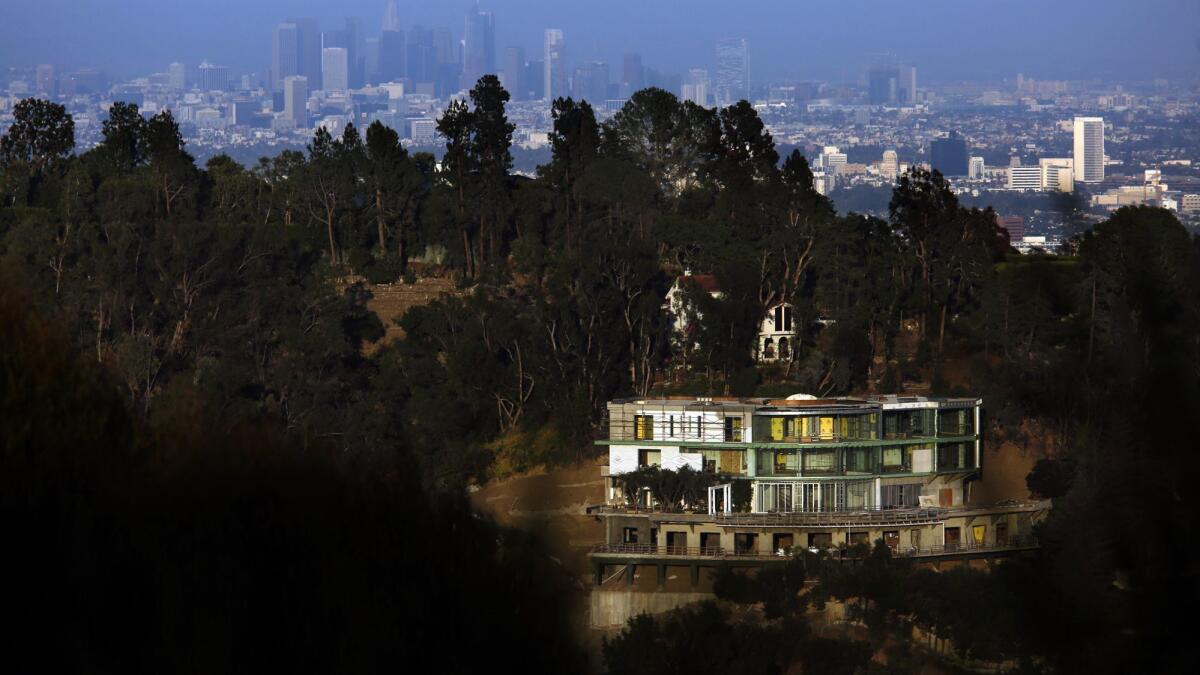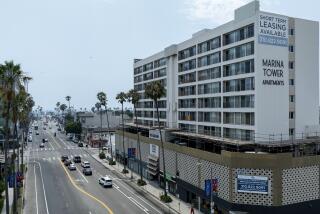The #latergram defense: Online posts spur questions in Bel-Air mansion case

Celebrities and wannabes sometimes opt for a “latergram,” posting an old snapshot from an earlier, more Instagrammable moment for online adulation.
Drake has rapped about it. Supermodel Bella Hadid has revealed doing it.
Now an attorney for her father, Mohamed Hadid — a real estate developer in hot water over a Bel-Air megamansion — has invoked it to defend him in court.
Hadid pleaded no contest last year to criminal charges tied to the colossal home on Strada Vecchia Road. Prosecutors said the house included entire areas, including bedrooms, decks and an theater, that were never approved by the city. He was sentenced to community service and fines and ordered to come up with a plan to stabilize the Bel-Air hillside.
But several neighbors, who are agitating for Hadid to tear down the mammoth building, claimed in a court filing this week that they had “strong evidence” that Hadid did not do his required community service. They pointed to Instagram posts that appeared to show him jetting to Luxembourg when he was supposed to be volunteering at a Los Angeles church.
How, their attorney George Soneff asked in court Thursday, could Hadid be in Luxembourg and L.A. at the same time?
The answer was simple, his attorney Robert Shapiro replied. Hadid was latergramming.
Shapiro told Superior Court Judge Eric Harmon that Hadid wanted to surprise his daughter Bella, so he pretended he was leaving town and posted old photos on Instagram from earlier travels, then popped up unexpectedly at her birthday party. The church where he was volunteering had concluded that his time sheets were accurate, Shapiro added.

Harmon said the Luxembourg posts seemed “fishy,” but did not rule Thursday on whether Hadid had violated the terms of his probation. Harmon said such an allegation would need to come from prosecutors, not the neighbors, and be vetted at a later hearing.
Supervising Deputy City Atty. Michelle McGinnis, who oversees code enforcement cases for the office, told Harmon the allegations raised by neighbors were being investigated.
In his legal filing, Soneff said the Luxembourg posts were just an example of the information they had assembled and that there were additional posts and photos that called his volunteer log into question.
Fake posts are “certainly a creative explanation,” Soneff said after the hearing. But to prove it, Soneff said, “I expect him to come in with his passport.”
The same group of neighbors, Beatriz and Joseph Horacek and John and Judith Bedrosian, filed a civil suit last month against Hadid and the city, arguing that L.A. had failed to enforce a longstanding order to either get city approval or tear down “all unauthorized, unapproved construction” on the Strada Vecchia site.
“At this stage, the only way to bring this illegal mansion into compliance is to tear it down and start over,” their attorney Victor De La Cruz said last month.
Soneff pointed back to that order in their filing this week in the criminal case, calling for the court to make Hadid turn over control of the property so that demolition could be carried out.

Hadid and his attorneys have stressed that the Bel-Air house was frequently inspected during construction.
In a court filing last summer, Shapiro and attorney Donald Ré wrote that it “would have been totally irrational for any person to believe that any of the construction undertaken on the site was not observed and approved by the city inspectors.”
Hadid told The Times last month that he nonetheless pleaded no contest to the criminal charges to “move on” and avoid embarrassing city inspectors. At Thursday’s hearing, his architect, Ignacio Rodriguez, said they had turned in plans for a smaller house on the Strada Vecchia site and were working diligently with the building department to address their corrections.
“You’ve got the city and Mr. Hadid cooperating to get this building into compliance and completed,” Shapiro said after the hearing. “Mr. Horacek has his own agenda.”
In legal filings last year, Hadid and his project manager Russell Linch alleged that Joseph Horacek had unsuccessfully sought anywhere from $2 million to $3.5 million from Hadid before launching attacks on his project. Linch called it “extortion” in a letter included in the court file.
Horacek called that “a gross distortion,” saying they had talked at one point about financial compensation for the lost value of his property, but that the discussion had occurred before he knew the full extent of the unapproved construction, and was predicated on confirming the site was safe.
“This is not about money,” Horacek said. “The whole point of the lawsuit is the safety of the neighbors.”
The next hearing in the criminal case is scheduled for September.
Twitter: @AlpertReyes
More to Read
Sign up for Essential California
The most important California stories and recommendations in your inbox every morning.
You may occasionally receive promotional content from the Los Angeles Times.











